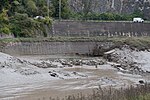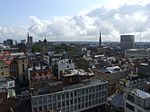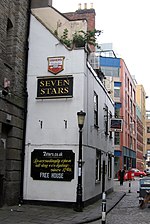Finzels Reach

Finzels Reach is a 4.7-acre (1.9 ha) mixed use development site located in central Bristol, England, on a former industrial site, which occupies most of the south bank of Bristol Floating Harbour between Bristol Bridge and St Philip's Bridge, across the river from Castle Park. A sugar refinery occupied part of the site from 1681, rebuilt by Conrad Finzel I in 1846 to become one of the largest sugar refineries in England. Known as Finzel's Sugar Refinery, it operated until 1881. Georges Bristol Brewery, founded in 1788, grew to occupy most of the site by the mid 20th century, when it was the largest brewery in southwest England. Known after 1961 as the Courage Brewery, it operated until 1999. The site also includes the former Tramway Generating Station, a Grade II* listed building built in 1899 which operated as the power station for Bristol Tramways until 1941. Development plans were approved in 2006, but work was halted in 2011 due to financial issues with the developer, HDG Mansur, following the 2008 recession and the site was subsequently put on the market in 2013, after the company went into receivership. The development was revived when the developer, Cubex, bought the site in 2014.In 2020 Gavin Bridge the Director who had led the development left Cubex to launch Spatia, https://spatiauk.com/about/, a regeneration and sustainable development business. https://www.businessleader.co.uk/property-developer-gavin-bridge-launches-new-venture-spatia/ https://www.insidermedia.com/news/south-west/bridge-launches-new-property-development-firm https://www.built-environment-networking.com/news/gavin-bridge-spatia/
Excerpt from the Wikipedia article Finzels Reach (License: CC BY-SA 3.0, Authors, Images).Finzels Reach
Hawkins Lane, Bristol Broadmead
Geographical coordinates (GPS) Address Nearby Places Show on map
Geographical coordinates (GPS)
| Latitude | Longitude |
|---|---|
| N 51.454 ° | E -2.589 ° |
Address
Hawkins Lane
Hawkins Lane
BS1 6WR Bristol, Broadmead
England, United Kingdom
Open on Google Maps










